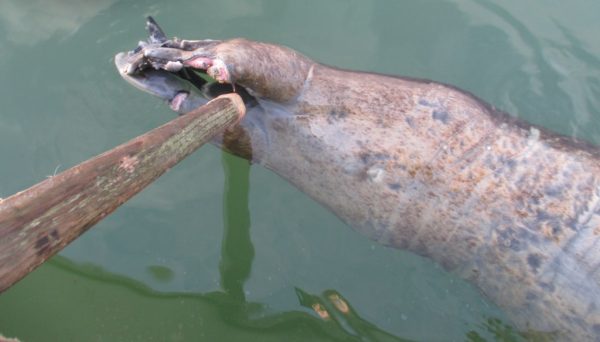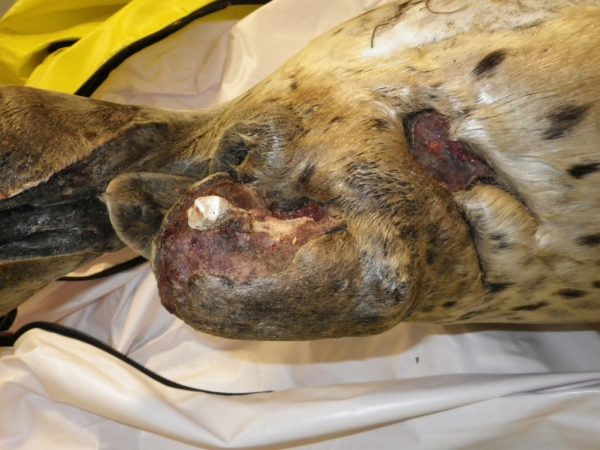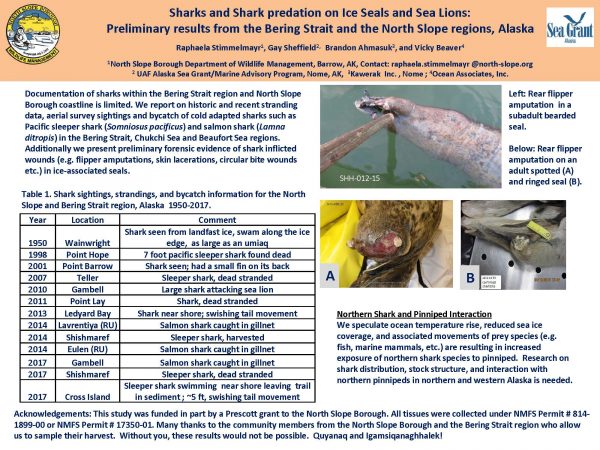Sharks may be eating more northern seals, sea lions
July 2, 2018
Paula Dobbyn
907-274-9698

Something new is happening in the cold waters off northern and western Alaska. Unusual injuries such as bite marks and flipper amputations are showing up on seals in the Bering Strait, Chukchi Sea and Beaufort Sea.
Ice-associated seals and Steller sea lions appear to be encountering a typically uncommon predator in these waters, according to scientists, hunters and subsistence managers.
The likely culprit? Sharks.
Several shark species are known to visit the western and northern coasts of Alaska, including sleeper, dogfish, Greenland and salmon sharks. A variety of northern shark species seem to be following the movements of prey species venturing farther north due to warmer ocean temperatures.
That’s according to a group of scientists and observers from Alaska Sea Grant, the North Slope Borough Department of Wildlife Management, Kawerak Inc., and Ocean Associates Inc. They have been recording injuries to or attacks on seals and sea lions through stranding and bycatch data, aerial survey sightings and marine mammal hunter observations.
“People are providing information on harvested seals with amputated flippers, because they don’t normally see that. These are not the marks of a killer whale. Killer whales have pegged teeth. The injury pattern would be different, and community members are noting these are novel injuries,” said Gay Sheffield, an Alaska Sea Grant Marine Advisory agent in Nome.
“In some injuries we’ve seen, bone has been sliced. There have been penetrating stab wounds and circular bite marks. The flesh is sometimes torn as if a sharp, triangular-shaped object has ripped the skin, leaving an upside down V pattern,” said Sheffield.

Sheffield shares information with, among others, Raphaela Stimmelmayr, a wildlife veterinarian and research biologist with the North Slope Borough. Stimmelmayr also tracks the unusual injuries.
“Some of the injuries reminded me of what I saw in sea turtles attacked by sharks when I worked in the tropics,” said the Utqiaġvik-based vet. “It’s very suggestive of shark bites.”
Both women are quick to point out that they don’t have enough evidence to explain the causes with certainty. By working with coastal communities, Kawerak and each other, they hope to learn what may be attacking the finned mammals known as pinnipeds. The scientists presented a poster about shark-pinniped interactions at the Alaska Marine Science Symposium in Anchorage in January 2018.
The poster is titled “Sharks and Shark Predation on Ice Seals and Sea Lions: Preliminary Results From the Bering Strait and the North Slope regions, Alaska." A table that lists shark sightings, strandings and bycatch dating back to 1950 shows increased reports from 2010 onward. Hunters that year reported a large shark attacking a several-hundred-pound bull sea lion in the waters off Gambell, a village on St. Lawrence Island.
“There are not many sharks that could kill a large sea lion,” Sheffield said, noting that she has no doubt as to the hunters’ observation.
Brandon Ahmasuk, subsistence resources program director with Kawerak, said the hunters who witnessed the attack described the bull sea lion leaping out of the water and then making a beeline toward shore. Next, they saw what looked like a huge shark before it dove below the surface. They soon saw a large pool of blood in the water and no sign of the sea lion.
“They estimated the shark was between 14 and 16 feet in length,” Ahmasuk said.
Currently, there is one record of a great white shark caught in the central Bering Sea during August 1979. It was at least 12 feet long. When the fisherman cut open its stomach, large chunks of Steller sea lion fell out, according to Sheffield.

It's unclear if shark attacks on pinnipeds are increasing or if people are observing them more. Some coastal residents of western and northern Alaska began to report more unusual marine mammal sightings beginning in 2011, when over 600 seals in northern and western Alaska beached themselves or were harvested. The seals were found to have skin lesions, hair loss, weakness or some combination of these. A cause of the disease was never determined.
The scientists tracking the suspected shark injuries have a working theory.
“We speculate ocean temperature rise, reduced sea ice coverage and associated movements of prey species (e.g. fish, marine mammals, etc.) are resulting in increased exposure of northern shark species to pinniped prey,” according to the poster.
It’s unclear whether more sharks in Alaska’s northern waters will have any major biological implications for seals and sea lions, Stimmelmayr said.
But it’s important to compile field observations and data to document changes, she said.
With historically low sea ice conditions in the Bering Sea in recent years, species are showing up that local residents haven’t seen before. These include Hanasaki crabs, also known as spiny king crabs, said Ahmasuk. Hanasakis, which taste similar to king crab, are historically found in Asia but have been documented in the Bering Strait region in recent years.
Ahmasuk said some other marine species are arriving earlier in the summer, such as salmon, as ocean temperatures warm. To him, it makes sense that there would be more sharks in northern waters as well.
“These animals listen to Mother Nature. They don’t follow the Fish and Game calendar,” he said.


